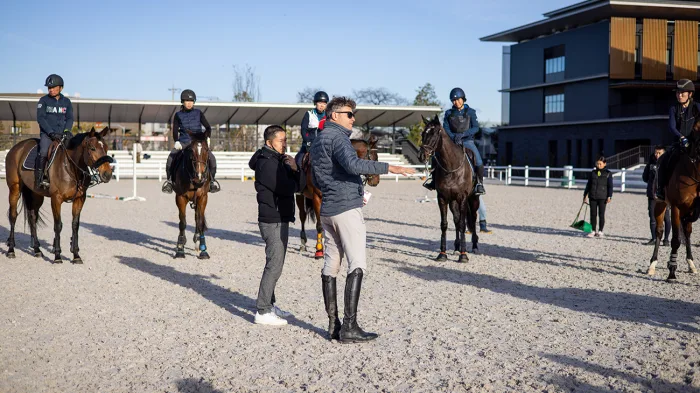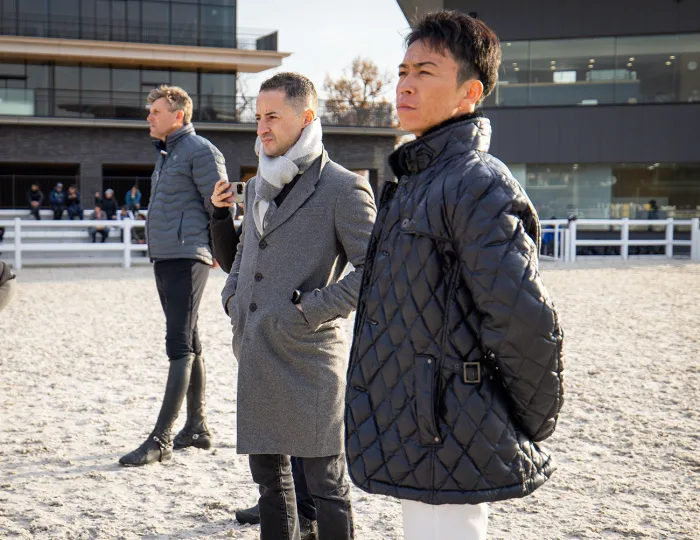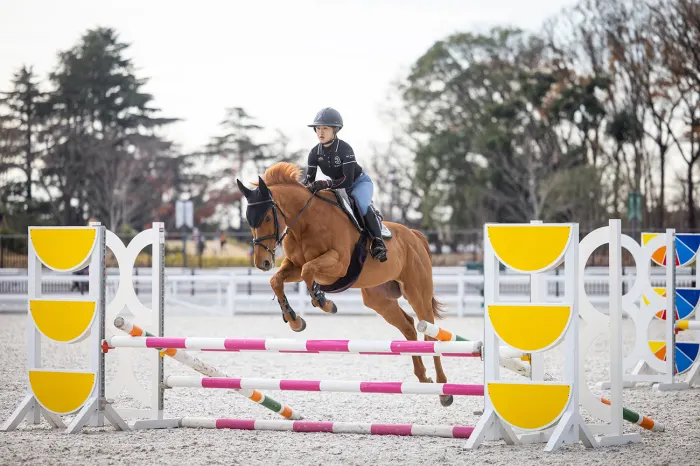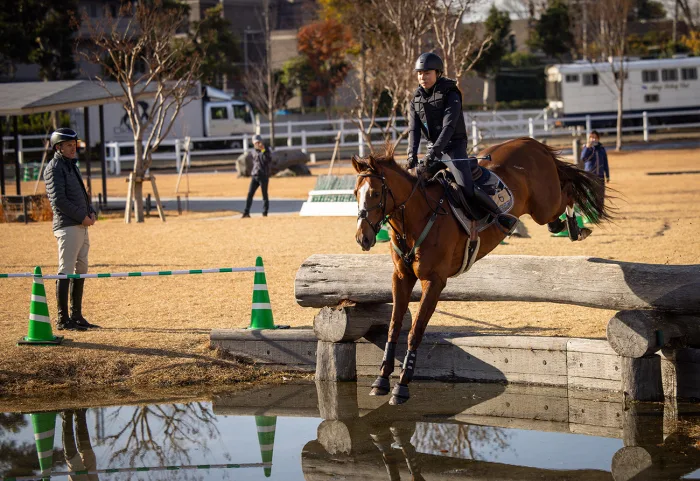Watching Boyd Martin gallop one of his five-star Thoroughbreds up to a massive cross country fence is breathtaking. Watching the three-time Olympian skillfully take a green off-the-track Thoroughbred from flatwork to jumping a course is a whole different lesson in horsemanship.
If you are among the tens of thousands of people who follow Martin on social media, then you’ve been watching him not only start “Remi,” a now-7-year-old OTTB registered as Gold Czar (Medaglia D’Oro—Pleasant Review, Pleasant Tap), in the U.S. but also recently saw him ride a 5-year-old ex-racehorse named Pan Pacific (Kizuna—Oceanway, Street Cry) in Japan. The horse was one of three dozen involved in a retired racehorse retraining clinic hosted by the Japan Racing Association and held Dec. 18-20 at Baji Koen Equestrian Park, the Tokyo Olympic venue.

“Look in; turning,” Martin narrates in a video shot the final day of the clinic, both showing and explaining how to ride the course while a translator puts his words into Japanese. “If I were on the Japanese team,” he finishes, “I would tell my other teammates that I think eight strides would be better to this jump,” detailing how going wide and slowing would better set up the turn.
Japan’s racing industry is growing more and more influential, sending eight entries to the Breeders Cup in 2023. And, like the U.S., the Japanese racing industry is feeling the urgency to improve Thoroughbred aftercare. According to the JRA, about 7,000 Thoroughbred foals are born in the country each year. Some of them compete on the higher level JRA circuit and others in a lower-level circuit management by local governments, known as the NRA.
Japan faced a particular aftercare reckoning when it was revealed in 2003 that Kentucky Derby winner Ferdinand, who went to Japan as a stud, had likely been slaughtered, which is legal in Japan. The JRA now has a robust program for retraining OTTBs.
Martin’s December trip to Japan was his fourth time leading the clinic, which was hosted by the JRA, the National Riding Club Association of Japan and Godolphin. The three-day clinic started in a classroom but soon moved out to the arena at Baji Koen, where Martin took 36 horses and their riders through the stages of introducing OTTBs to their new careers in jumping, dressage and eventing, with the horses broken into groups based on their intended future disciplines.
Martin’s own ties to OTTBs include the $850 ex-racehorse Neville Bardos, who made the Australian-born rider a household name in eventing, and Blackfoot Mystery, who he rode at the 2016 Rio Olympics. Martin first went to Japan to promote the retraining of racehorses in 2017.
On the first day of the clinic, Martin started the jumping horses with ground rail exercises walking over the poles at first to “just to get them understanding of where their feet were.” As they progressed to trotting, he noted that trot pole work is “good for the horse’s footwork and then also can elevate the trot a bit.”

“I really wanted just to get a feel for all the horses and riders and see where they’re at,” Martin said. “A lot of the horses here have been started very, very well and came straight out and did all the simplistic exercises very well.”
The horses then moved to cantering poles on a curve and a short one-stride, and did “a bit of a lengthening and shortening exercise where it was a short five strides to a little bit of an open five strides” and ending the session with very small jumps 4 inches off the ground, building toward the next day’s gymnastics.
The dressage horses, he said, had already established their basics and so worked on relaxation and being happy in the big arena.
“We did a little bit of stretching work to get the horse using its back muscles,” Martin said. “Then in the canter work we did a bit of lengthening and shortening the stride.”
Toward the end of the session, the riders went back to trot work and did some lateral movements, “working at the horses going forward and sideways in the leg yield.”
ADVERTISEMENT
Martin addressed—both in Japan and in his training videos with Remi—what is needed to relax OTTBs, which is not the same as assuming all Thoroughbreds are hot.
“It can be hard to predict temperament,” he said of choosing an OTTB. “Some calm down after racing and others stay more excited.”
Of Remi, he said, the horse was “born, designed and bred to be a galloping machine, and for him to turn into a ballerina is going to be quite the challenge.” He cautioned, “Be patient, don’t ask for too much too soon.” In Remi’s case, his previous owner had spent a year hacking and slowly working the young horse, who was a product of a Godolphin stallion.
A long session under saddle can affect horses differently, he said. Some horses get quiet and relaxed, “and some of them get more and more wound up, and you are better off with a shorter session.” He suggested that, for showing, horses that don’t do well with a long warm-up might do well with a longer ride early in the day, followed by a hosing off (or a “shower,” as Martin put it) and then being brought out again later for a brief warm-up just before their turn in the show ring.
The second day of the clinic featured not only a progression of the horses’ training, but also the attendance of two well-known JRA jockeys, Christophe Lemaire and Hiroshi Kitamura. As the jockeys watched the dressage session, they realized they were watching horses they had once ridden in races. Martin called that “a real buzz.”

“It was a touching moment seeing their former partner at the racetrack pursuing a new sport and a new life in their second career as a sport horse,” he added.
Lemaire, who had the most wins at JRA racetracks for five consecutive years from 2017 to 2021, called it a pleasure to watch the horses enjoying the new challenges of their second careers.
The dressage horses used their second clinic day to begin working on some of the movements they might be asked to do in a competition, and the final day to put their budding skills to the test in a competition dressage arena.
“I felt like all the dressage horses improved every day,” Martin said. “They came out better and better. The first day they were a little bit nervous and tense, and the second day they were better, and [the last day] they were fantastic.
“I feel like we were introducing some new lateral work and different dressage movements that the riders will need to be good at when they take the horses to the show,” he added.

Wondering how the Australian-born turned enthusiastic American Boyd Martin discusses the intricacies of dressage with speakers of a completely different language?
In another video, with his signature Down Under affability, Martin introduced his translator, Kosuke “Kosi” Kawakami, who moved to Australia to work a jump jockey and later became a professional translator. Together they addressed some of the difficulties translating the nuances of horse sports.
Kawakami said his background in riding helped when communicating to the jumping groups, but “when it comes to the dressage,” with its specific terminology, “I suck at it.”
ADVERTISEMENT
Martin begged to differ—though he pointed out he doesn’t actually know what Kawakami is saying, anyway. As for when Martin might say “something inappropriate,” Kawakami said, “When you go over the limit, I just shut my mouth.”
“I thought that,” Martin mused, “because I said some pretty funny jokes, and no one laughed.”
With Martin’s coaching and Kawakami’s translations, the jumping horses moved from the first day’s pole work to improving each horse’s technique with gymnastics and grid exercises.
Martin used placing poles to encourage the green horses to take their time to the fences. Another exercise featured a series of three verticals set on a short three strides with V-poles on the fences.
“I think one of the hardest things to do with the off-the-track Thoroughbreds,” Martin said, “is getting them slowing down between the fences.” The V-poles combined with the short distance, plus some placing poles, he said, “really encourage the horse to hop over the jump and slow itself down to the next fence and again to the third fence.

Martin demonstrated the same slowing down idea at home with Remi, discussing how he will land and come back to walk “so after every jump, he’s thinking ‘slow down and easy does it.’ ” He noted also that, especially when jumping verticals on young horses, he likes to use wide groundlines to improve the horse’s technique and keep them from getting underneath the jump.
Day three for the jumpers revolved around “what these horses are going to be faced with at the competition,” Martin said. The riders warmed up over a vertical and then an oxer and next did a course once at a low height and then, with some adjustments for the different horses and riders, did it the second time higher.
“I felt like this was a productive exercise, just because at the end of the day the retired racehorses’ new career is a competition sport horse,” Martin said, and this gave “a bit of a feeling of how the horses are going to compete at their first show.”
The eventing groups not only experienced the arena at Baji Koen, they were able to finish the clinic by cross-country schooling. First, Martin worked on the riders’ galloping position, then introduced some single fences and riding over undulating ground.
“[Thoroughbreds] are already wonderful gallopers,” he said, “so it was more just working with the riders to get the horses in a good balance.”
After practicing individual questions like ditches, coffins, banks and narrower fences, Martin put a small course together to imitate a horse trials.

“It’s very rewarding each year we come out here,” Martin said. “I just feel like the riders are getting better and better, and more importantly the Thoroughbred horses that are attending the sessions are more and more awesome.”
Follow Boyd Martin’s work with Remi on Facebook at the OTTB Chronicles.













